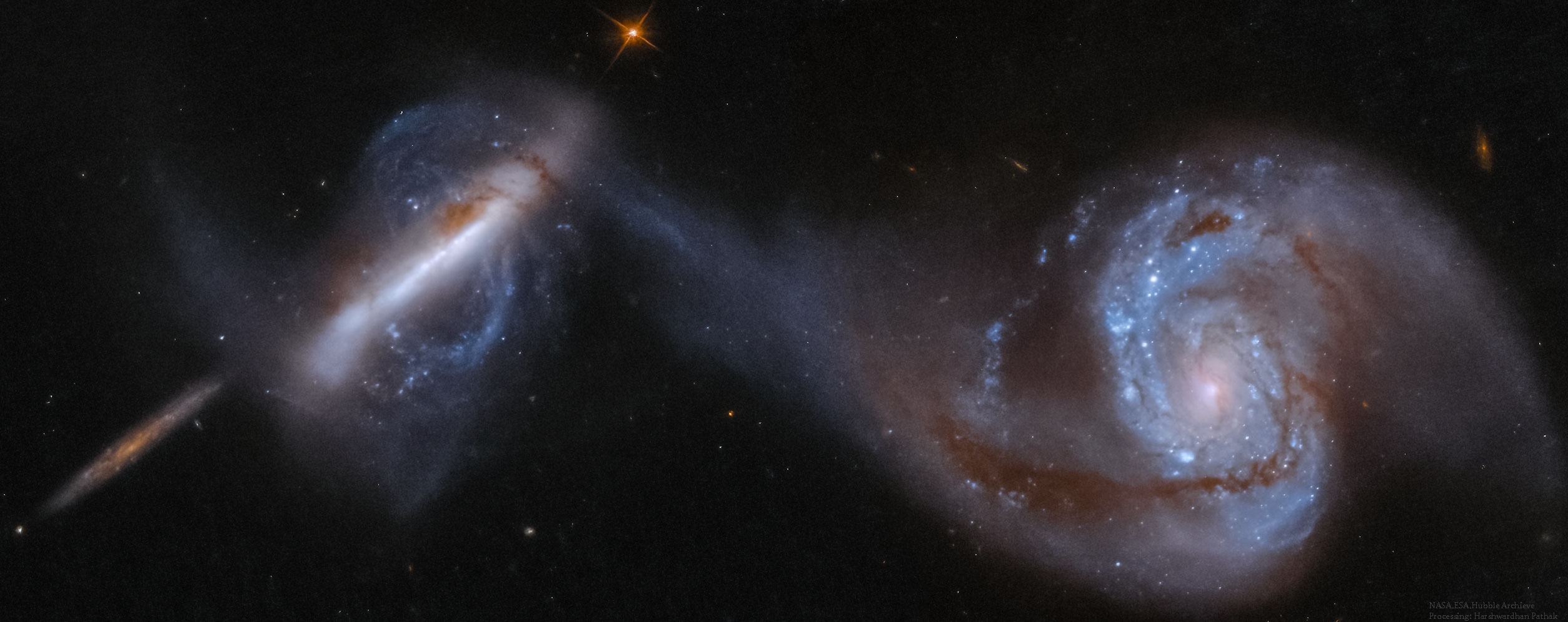Wow, what a fascinating pair!

Since I'm a lover of all things blue, today's APOD obviously has me smiling. I checked Arp 87 with my software, and the two galaxies are indeed relatively blue, even though they are sufficiently far away that redshift reddening should affect them at least a little bit. Fascinatingly, it is the smaller, edge-on galaxy, NGC 3808B, that has the bluest colors, both according to my software and according to Simbad. And indeed, you can see that the long bar or edge-on disk of NGC 3808B is brilliantly white, probably from large numbers of very hot stars.
Which brings us to this...
How can you tell at a glance that the galaxy to the lower left of NGC 3808B is a background galaxy? You can tell because the the other galaxy is both smaller-looking and decidedly redder than NGC 3808B. It is redder because of redshift reddening, and it looks smaller because it is farther away. In reality, this galaxy is probably quite big. It has a large disk, and we can see dust lanes in the disk. This is a large, undisturbed galaxy.
Which brings me to this...
NGC 7733 and NGC 7734 form another fascinating interacting pair. But there is a third galaxy making an appearance here. This galaxy looks like a yellow-brown blob in the upper arm of galaxy NGC 3377.
But we can tell at a glance that "the blob" is a background object. How? Well, because it is small and reddish. But also because it seems to sit inside the upper arm of NGC 7733, but NGC 7733 is absolutely undisturbed by its presence. That would almost certainly not have been the case if this brown blob was a true dwarf galaxy tangled in one arm of NGC 7733. Just look at what dwarf galaxy NGC 1510 is doing to the arms of NGC 1512!
Of course, there is also NGC 6050, which is a pair of interacting galaxies with a most strange little dwarf galaxy that is positively entwined in an arm connecting the the two larger galaxies. Yes, but at least this arm seems to
feel the presence of this "extra galaxy" - oh well...
Anyway. What is most fascinating about today's APOD is how a stream of gas and stars from NGC 3808 seems to wrap itself around the disk of NGC 3808B to form a polar ring. Polar ring galaxies are so rare, but they are so fascinating!
NGC 4650A is an iconic polar ring galaxy. And just like NGC 3808B, NGC 4650A is located close to another, larger galaxy! The designation of this larger galaxy is - you guessed it - NGC 4650.
And indeed, NGC 4650 and NGC 4650A have the same recessional velocity. They are indeed close enough to be interacting. Although, as you can see, there is another galaxy that is even closer to NGC 4650. My amateur guess is that there are no
current large scale streams of gas and stars between NGC 4650 and NGC 4650A, and that the polar ring of NGC 4650 could be a remnant of past interactions between NGC 4650 and 4650A, when the two galaxies were closer to one another.
So is it true, then, that polar ring galaxies are formed through interactions with another galaxy? Or else, perhaps the "polar ring galaxy to be" just "happened upon" a large detached gas cloud and interacted with it to form a polar ring?
Questions, questions. I can only offer speculation, unfortunately!
Ann
 Arp 87: Merging Galaxies from Hubble
Arp 87: Merging Galaxies from Hubble




